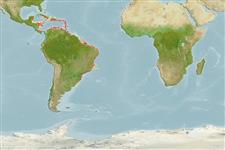Common names from other countries
Environment: milieu / climate zone / depth range / distribution range
Ecologia
; estuarina; intervalo de profundidade 0 - 5 m (Ref. 83435). Tropical; 21°N - 35°S, 89°W - 34°W
Western Atlantic: Caribbean Sea to Brazil, subtropical south America; 16°N to 33°S.
Length at first maturity / Tamanho / Peso / Idade
Maturity: Lm ?, range 1 - ? cm Max length : 3.7 cm SHL macho/indeterminado; (Ref. 130712); Idade máx. registada: 3.00 anos (Ref. 104267)
Found in the intertidal zone to a depth of 1.5 m (Ref. 104267). Lives slightly buried in muddy sands of shallow water environments, particularly in mangrove lagoons (Ref. 81903). Adults prefer to settle in areas with fine or coarse sand where conditions are harsher during low tide (Ref. 104267). Strictly a filter-feeder (Ref. 104242). Suspension feeder (Ref. 105167). In general, suspension feeding bivalves mainly depend on phytoplankton and detritus material for nutrition (Ref. 107088). Sensitive to salinity variations but resistant to hypoxic conditions (Ref. 104267). Associated with a crab (Refs. 104147, 105309), bivalve and polychaetes (Ref.105309).
Life cycle and mating behavior
Maturidade | Reprodução | Desova | Ovos | Fecundidade | Larvas
Members of the class Bivalvia are mostly gonochoric, some are protandric hermaphrodites. Life cycle: Embryos develop into free-swimming trocophore larvae, succeeded by the bivalve veliger, resembling a miniature clam (Ref. 833).
Barreira, C.A.R. and M.L.R. Araújo. 2005. (Ref. 81737)
Categoria na Lista Vermelha da IUCN (Ref. 130435)
Categoria CITES (Ref. 108899)
Not Evaluated
Not Evaluated
Utilização humana
Pescarias: espécies comerciais
| FishSource |
Ferramentas
Fontes da internet
Estimates based on models
Preferred temperature
(Ref.
115969): 22.6 - 28.4, mean 27.5 (based on 264 cells).
Resiliência
Elevada, tempo mínimo de duplicação da população menor que 15 meses (K=0.69; tmax=3).
